One of the things I love about bread is its versatility. Even a shop bought loaf can be used in a dozen different ways, from slices of toast to sandwiches, breadcrumbs to bread and butter pudding, the savoury crunch of a crouton or stirred through smooth sweet ice cream. And when you start to bake your own, the combinations are endless – crusty loaves and fluffy rolls, baguettes and baps, sprinkled with seeds, or run through with olives and cheese, fruit, nuts and more.
When I first started writing this blog, I made it my mission to bake my own bread on a regular basis. I’ve since experimented with various different flours and techniques, but the staple loaf I return to time and again is a simple mix of wholemeal and malted grain flour. The latter is fairly forgiving, lending the loaf a lovely lightness of texture and depth of flavour. I tend to do my baking on a Sunday afternoon, and each week a freshly baked loaf of bread makes getting up on a Monday morning just that little bit easier.
For those who haven’t been bitten by the baking bug, making your own bread can seem a daunting and even pointless task. Some are simply scared of yeast and kneading, while others argue that they just don’t have the time or that shop-bought bread is cheaper and more convenient. I’m not going to try to take too much of the moral high ground here – each person has their own priorities and there are things I’ve never had the patience to try, like making my own clothes or growing my own vegetables – but if you’ve never had a go at making your own bread, I would urge you to. It really is one of life’s simplest, but greatest pleasures.
It’s also pretty economical. Depending on the quality, a kilo of flour – enough for 3 or 4 loaves – will set you back about a pound, the price of a basic sliced loaf or half a single shop-bought sandwich. The average office worker spends over £600 a year on pre-made lunches and sandwiches, and if you live in London I imagine that cost is significantly higher. Make your own bread and you enter a whole new world of homemade sandwiches, where the soggy lettuce leaf, slick of greasy mayo and swathe of artificial additives, hydrogenated oils and unhealthy preservatives you find in so much shop-bought bread become a thing of the past.
If the malted wholemeal loaf is my every day option, suited and booted for the working week with a sensible amount of whole grain and fibre, the loaf that follows is its seductive Saturday morning sister. Easy to throw together, this lazy little loaf has a beautiful soft texture, tender crumb and delicate, buttery flavour, perfect sliced and spread with Nutella, sandwiched around crispy bacon or toasted and slicked in salty smooth butter.
The first time I made this loaf, Carniverous Boyfriend and I devoured practically the whole thing in one sitting. I made it again this weekend for visiting friends, and the empty bread bin this morning tells a similar story. Today my sensible brown bread sandwich is all packed up alongside my gym bag, signaling the start of another healthy working week, but when it gets to next weekend, I know what I’ll be reaching for come breakfast time.
Do you have certain foods you save for the weekend? Have you been bitten by the baking bug? And do you prefer white or brown bread?
Simple white farmhouse tin loaf (from Dan Lepard’s Short & Sweet)
This recipe uses Dan’s amazing low-maintenance kneading technique. Rather than pummeling the dough until your arms are numb, it requires just a few gentle folds and turns at intervals spaced out over about an hour. I’ve included the basic details below, but for the full techniques and tips on making the perfect loaf, I’d recommend buying your own copy of baking bible Short & Sweet. That way you get to master the tricks of the trade, and I don’t get sued by Dan for reproducing his recipe below.
Ingredients:
225ml warm water
1 tsp fast action yeast
350g strong white flour, plus extra for shaping & dusting
1 tsp fine salt
25g salted butter, plus extra for greasing the tin
Method:
First of all, make the sponge. Pour the warm water into a large bowl with the yeast and 175g of the flour. Stir well with a wooden spoon, cover the bowl with a tea towel and leave for 2 hours minimum. You can also leave this overnight, or make it in the morning before work and finish making your bread in the evening.
When you’re ready to make the dough, pour the remaining 175g flour into a clean bowl, add the salt and rub the butter through until it vanishes. Pour in your sponge and mix the whole lot into a big sticky lump of dough. Cover with a tea towel and leave for 10 minutes.
After ten minutes, tip the dough onto a clean work surface. Take the edge of the dough furthest away from you with one hand and fold it towards you, to meet the edge of the dough nearest to you. Then with the heel of your other hand, push it lightly into the dough and stretch it away from you. Turn the dough clockwise by a quarter and repeat the process. Do this no more than 10 times, then return the dough to the bowl. Repeat again after a further 15 and 30 minutes.
After this third knead, leave the dough covered with a tea towel for 30 minutes. Butter and flour a 19cm loaf tin then preheat the oven to its highest temperature (220 degrees C if possible).
Lightly flour the work surface, tip out the dough and roll into a rectangle approx. 2cm thick and slightly less wide than the loaf tin. Roll it up tightly and place seam-side down in the tin. Cover with your tea towel and leave until increased in size by half (1 – 1/2 hours).
When the loaf has risen, take a sharp knife and slash across the top. Dust with flour and bake for twenty minutes, adding a little steam to the oven to help achieve a perfect crust if you like. After 20 mins, reduce the heat to 200 degrees C and bake for a further 20 – 25 minutes until the crust is the colour you like.
Remove from the oven and leave to cool (if you can wait that long) before slicing. Eat and enjoy.
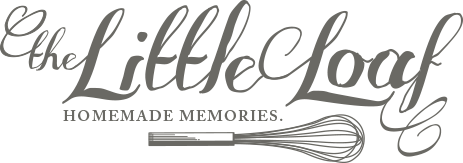





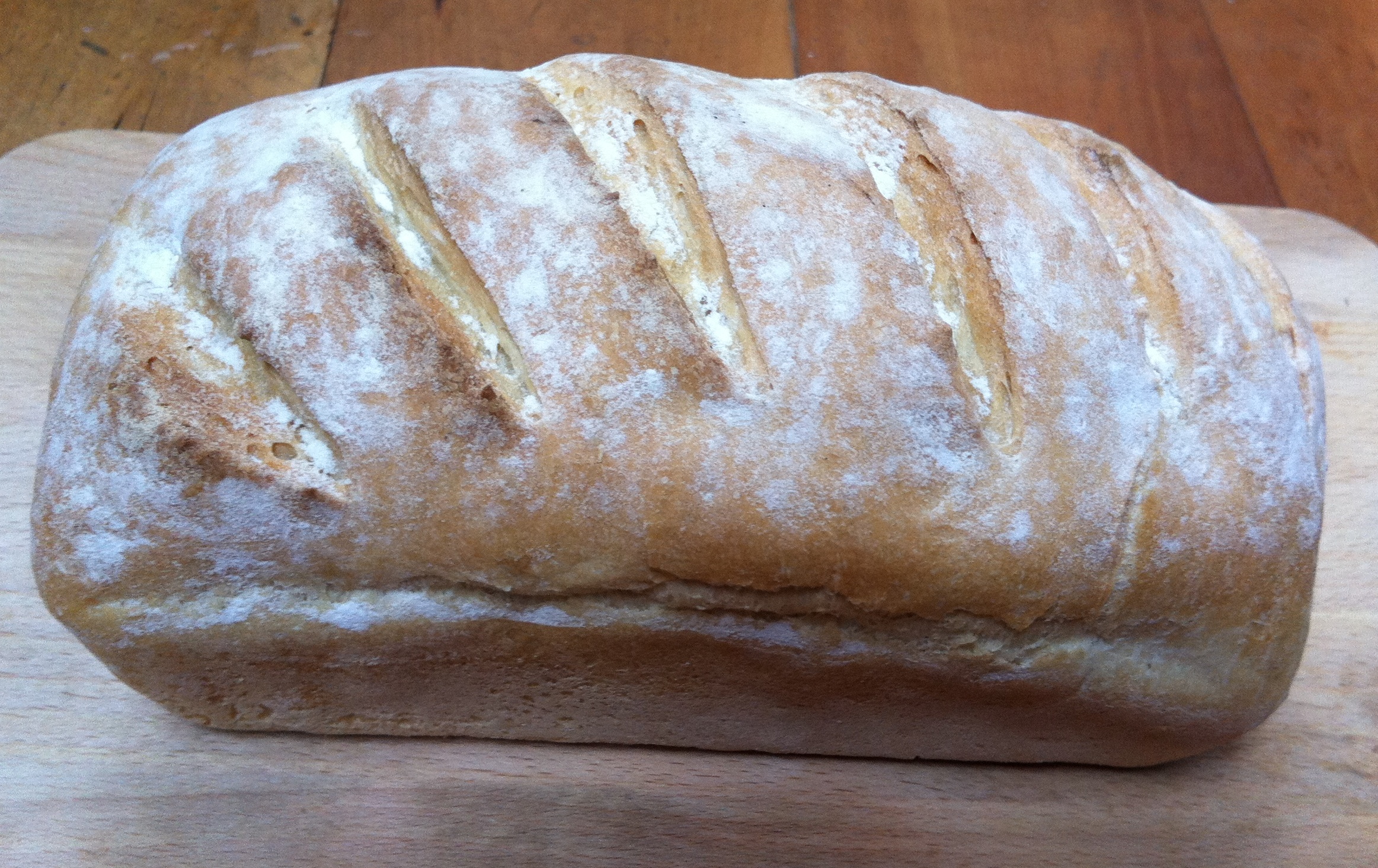
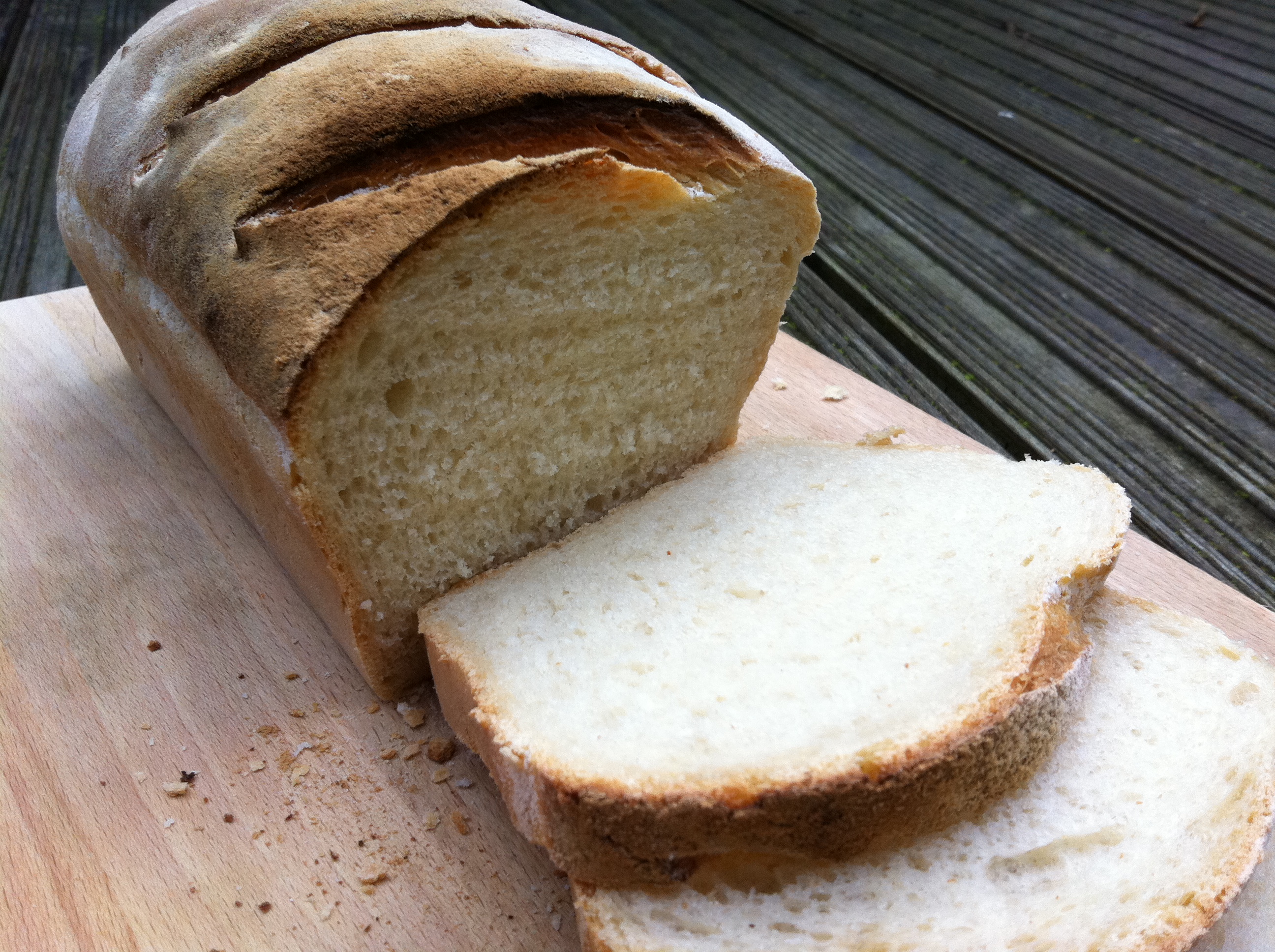
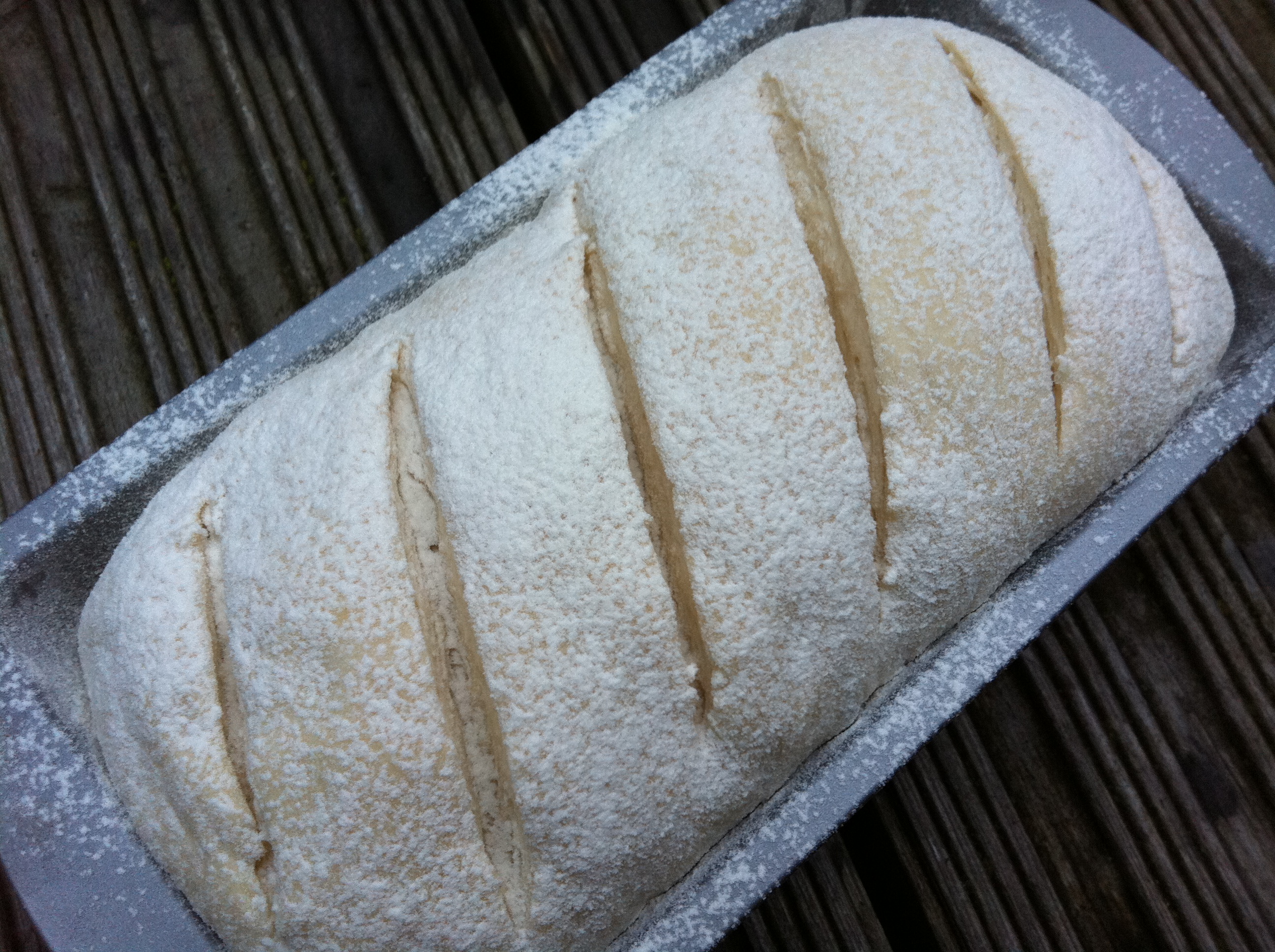
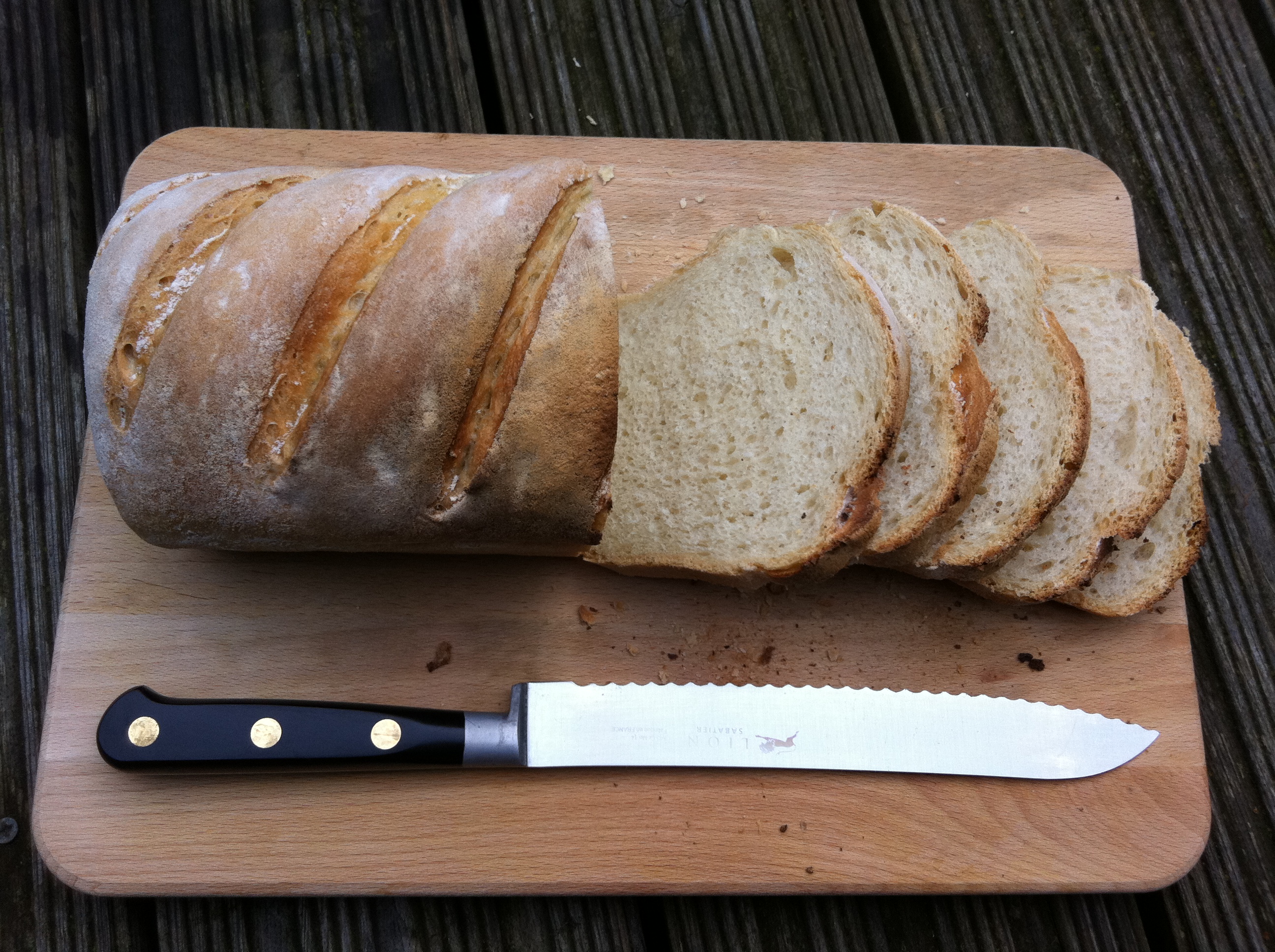
I love making my own bread. When I do, I always bake one and freeze one!
This bread looks like it has the perfect texture – wonderfully light and airy! I’m really looking forward to getting a copy of Dan’s book in a couple of weeks, maybe this will convince me to start baking my own bread more often?!
Baking homemade bread loaves are lovely. I remember making them as a child with my grandfather who absolutely loves to bake bread (and still does). with his own breadmaker. Yours looks so delicious, I love crusts from bread loaves the best!
How funny! I made this recipe for the first time yesterday and, as it was guzzled so fast, I’m making the same again today. Fabulous loaf.
looks like the perfect bread to make grilled cheese sandwiches and french toast!
As usual, super impressed with your bread making skills. This loaf looks so perfect! For toast with butter or nutella, it has to be white bread for me.
I have been baking bread myself for about a couple of years now and do not know why I didn’t begin sooner. You’re right, there really is nothing quite like it. I find it very therapeutic! Dan lepard’s technique is very different from how I do it though….must try this method out instead of putting it all in theKitchenAid 🙂
Your bread looks beautiful!!! I love baking my own bread. It’s not only having freshly baked bread in the house, it’s the wonderful smell of freshly baked bread too.
I’ve never made my own bread apart from in a bread machine which doesnt count. I need to get my hands on this book and try making my own bread for a change!
that looks perfect! you can’t beat the smell of freshly home-baked bread!
Ah this looks so wonderful. i imagine myself enjoying a barcon sarnie on a lazy Sunday morning. Thank you for the fantasy! I think I will make it a reality this weekend!
What a beautiful, classic loaf! And I was bitten by the baking bug as soon as I got my mixer with a dough hook. I love making it now if I have the time! 🙂
I have been wanting to make my own bread for ages. I used to have a breadmaker and made it all the time, even though it was cheating, I know… Now I have mixer with a dough hook too and keep promising I will really bake my own bread. This is exactly the kind of bread my kids would love to smear with Nutella. I will try it. And yes, I definitely have week end food and during-the-week food. Just like you, we try to eathealthier and lighter during the week and totally splurge on week ends, starting from breakfast.
Regula – I really should use my freezer more often! I get scared that it will ruin the texture of the bread – do you think you can taste when bread has been frozen?
London Bakes – Short & Sweet has some seriously gorgeous – and easy – bread recipes requiring practically no kneading, perfect if you’re new to breadmaking. Lots of flour variations in there too which is refreshing.
Sophie – absolutely agree, the crust is the best bit!
Jen – I think it’s the butter you rub through – such a small amount but it makes the bread insanely moreish.
Jennifer – it would be perfect for grilled cheese and French toast, good call 🙂
Mandy – thank you. Agreed on the Nutella front, it’s absolutely not the same on brown bread.
Laura – do have a go at Dan’s method, it’s so simple and has incredible results. I’m getting a Kitchen Aid for Christmas so may take that all back once I’ve been lured into using the dough hook instead of kneading by hand 😉
Jennifer – there’s nothing quite like a kitchen filled with the smell of freshly baked bread, yum.
Baking Addict – do it! I promise you won’t be disappointed.
Shu Han – thank you 🙂
Anna – it’s definitely the perfect bread for a bacon sarnie, slathered with salty butter soaked ever so slightly with the crispy bacon fat. Yum.
Lorraine – I always knead my loaves by hand but once I have my new Kitchen Aid I’m definitely going to experiment with using a machine to compare.
Nuts About Food – there’s not much that beats a long indulgent breakfast at the weekend. Or Nutella on thick white bread. I’m with your kids 🙂
Great to see a loaf recipe on the Little Loaf. You have inspired me in the bread baking stakes!
I’m one of those scared of yeast people, but I bought some fresh yeast yesterday on a bit of a whim and now I know exactly what I’m going to try this weekend.
I actually hardly ever eat bread because I can never finish a loaf without it going off and a shop bought loaf is surprisingly pricey, especially when you only eat a third. I look forward to this and the chance to eat more butter!
I want to cut a few slices of this and get the toaster on straight away. There is nothing quite like the smell and taste of toast made with good white bread. Sadly, I don’t get to try it very often because my puritan streak comes out in the bread department. I indulge with cake, but I make my own rye sourdough for bread – it is delicious and I love it dearly, but maybe, just once in a while I ought to let go and bake a loaf such as yours!
It’s a beautiful loaf with a nice light airy crumb to it. I think baking bread is one of the most rewarding things you can do in the kitchen.
I do the same as Regula …bake a couple, cool thoroughly and double bag one.. then freeze it. I feel that it is impossible to tell it has spent a week or so in the freezer. That’s about all they usually get to spend in there so perhaps it isn’t long enough to make it taste odd.
Your beautiful bread is inspiring me to get serious about baking my own bread! I have talked about it for years, but never seem to get with the program.
-Erin
Gourmet Chick – glad to provide some inspiration!
Miss South – I never find finishing loaves of bread a problem 🙂 But have you ever considered any bread-y recipes – croutons, panzanella, pappa al pomodoro, breadcrumbs – all a great use for leftover and slightly stale bread.
Choclette – it’s hard to break out of habits, and I’m a bit wholegrain or sourdough fan, but it’s worth trying something new every so often, and if you’re going white, this is the one to try!
Sylvie – thank you. There is a certain magic that comes with bread making.
BumbleVee – thanks for the tip, maybe I will try freezing next time I bake.
Erin – so glad to have provided some inspiration! Do let me know how you get on 🙂
I love baking my own bread, it’s so relaxing. This sounds like a great technique, I have to give this a try. Thanks for sharing.
Pingback: An Introduction to Bread Making with Richard Bertinet | thelittleloaf
Pingback: thelittleloaf 2011: A Year in Review | thelittleloaf
Pingback: Sesame Milk Loaf | thelittleloaf
Finally did it… Though I was kinda confused with the 10,15,30 gap kneading but turn out NICE.. BUT still doesn’t seems to please my fussy husband who insisted that store bought white loaf (RM2.50) is BETTER! I’m glad with the result though…
Just made this bread today and it turned out perfectly! I added just a little water to the dough as it seemed a tad dry, maybe 1/4 cup? At any rate, the loaf turned out so well, my very first success with breadmaking. This recipe is a keeper for me and will be used many, many times. Now I’ll go buy the book 🙂
So pleased the recipe worked well for you. Different flours sometimes absorb a little more or less water so it’s always good to see the recipe just as a guide x
Thank you so much for sharing this amazing recipe! I made the sponge this morning and have spent the afternoon tending to this amazing loaf, it’s the first time I have tried using this technique and the best white loaf I have made yet! I will have to get the book now!!
I absolutely love reading your blog – I have just discovered it after starting to get into baking in a much bigger way (it’s always been a passion but more of a hobby and now I’m trying to pursue it as a future!), it is so inspirational and you have a wonderful way with words too! Thank you xx
What a lovely comment, thank you so much Daisy 🙂 So pleased you like the loaf xxx